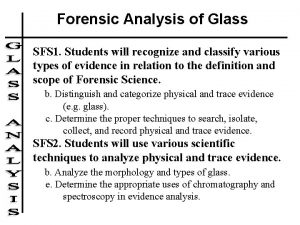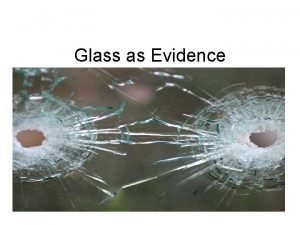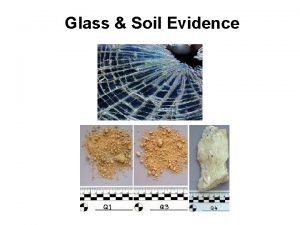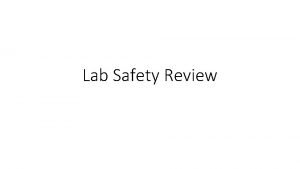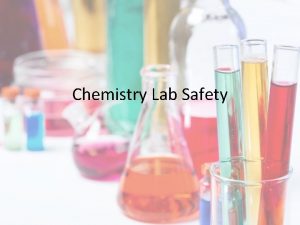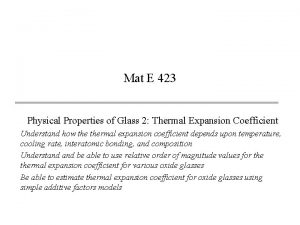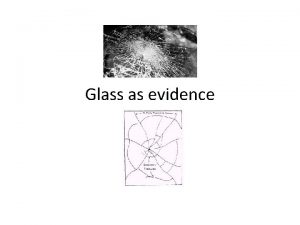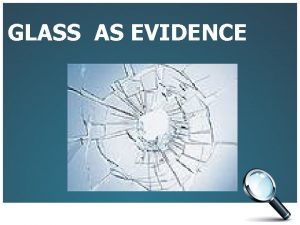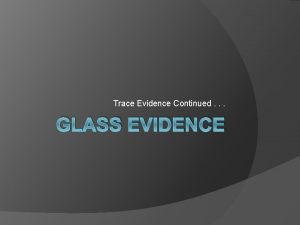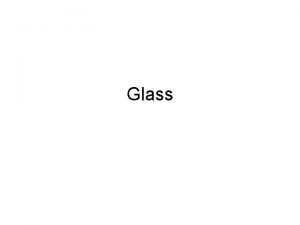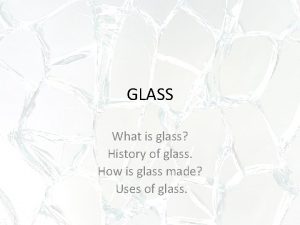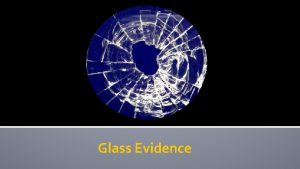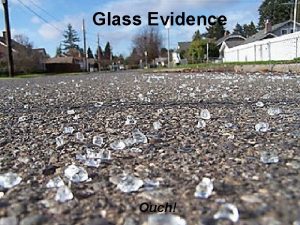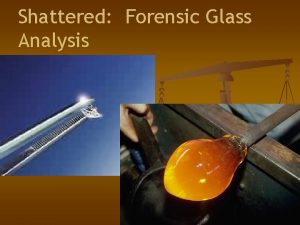Glass as Evidence Properties The composition of glass




























- Slides: 28

Glass as Evidence

Properties The composition of glass is unique and therefore identifiable. • What are some CLASS characteristic of glass

Physical vs. Chemical Properties • chemical composition (Si. O 2) • density (Physical) • refractive index (Physical)

Physical vs. Chemical Properties • The bending of light waves because of a change in velocity is called refraction.

How to find the Refractive Index Submersion method—used when glass fragments found at the crime scene are small Forensic Science: Fundamentals & Investigations, Chapter 14 5

Refractive Index • Place the glass fragment into different liquids of known refractive indexes • The glass fragment will seem to disappear when placed in a liquid of the same refractive index Forensic Science: Fundamentals & Investigations, Chapter 14 6

Video • http: //forensicsglassevidence. weebly. com/video. html

• Becke Line a halo-like effect appearing at the edges of a glass fragment Glass has higher refractive index-note white line inside • Glass has lower refractive index-note white line outside

What is Glass? • Glass is an amorphous solid. • Silica’s chemical name is silicon dioxide Would this structure affect HOW glass breaks?

10

Types of Glass Safety Glass

What type of glass is this?

How is glass used by Forensic Scientist?

Glass as evidence • • • By analyzing the fracture patterns: 1. what object hit the glass 2. from which direction the object came 3. sequence of events 4. composition of specialized glass

CLASS or INDIVIDUAL EVIDENCE ?

Glass is Class Unless…. Glass evidence is considered class evidence, because it is mass-produced However if pieces of broken glass fit…

Slo mo glass • https: //www. youtube. com/watch? v=k. XNA 6 z. Af 8 uw&list=PLxz. BK 3 jp 20 D 46 KGEXZ 1 K 7 z. Jp. FGMLt. Ylrk&index=1

What pressure is found on ENTRY and EXIT side of glass?

Compression and Tension

ROT • Radial-----Opposite side----Tension

CSC • Compression---Same side---Concentric •

Primary Stops Secondary Forensic Science: Fundamentals & Investigations, Chapter 14 22

Path of a Bullet Passing through Window Glass perpendicular to the glass shot from the left shot from the right • The angles at which bullets enter window glass help locate the position of the shooter • Bits of the glass can fly backward (backscatter), creating trace evidence Forensic Science: Fundamentals & Investigations, Chapter 14 23


Entry and Exit holes

Handling of Crime Scene Glass Samples 1. Photograph glass samples before moving them. 2. Collect the largest fragments 3. Identify the outside and inside surface of any glass. 4. Sketch. 5. Note trace evidence such as skin, hair, blood, or fibers. 6. Package all materials collected to maintain the chain of custody. Forensic Science: Fundamentals & Investigations, Chapter 14 26

https: //www. youtube. com/watch? v=Whjma 0 lr. SXs Forensic files-shattered dreams

 How glass is made
How glass is made Hzfc-d
Hzfc-d Glass ionomer cement definition
Glass ionomer cement definition Fulgurities
Fulgurities Glass forensic science
Glass forensic science Glass analysis forensics
Glass analysis forensics Secondary sources
Secondary sources Primary evidence vs secondary evidence
Primary evidence vs secondary evidence Primary evidence vs secondary evidence
Primary evidence vs secondary evidence Primary evidence vs secondary evidence
Primary evidence vs secondary evidence Jobs vancouver
Jobs vancouver Why are fibers class evidence
Why are fibers class evidence Class evidence vs individual evidence
Class evidence vs individual evidence Difference between physical and testimonial evidence
Difference between physical and testimonial evidence A pair of latex gloves was found at a crime scene
A pair of latex gloves was found at a crime scene Appeal to pity examples
Appeal to pity examples Study of composition structure and properties
Study of composition structure and properties Becke line
Becke line Glass evidence in forensic science
Glass evidence in forensic science What is the greatest value of class physical evidence
What is the greatest value of class physical evidence What is the glass escalator
What is the glass escalator Does hot glass look the same as cold glass
Does hot glass look the same as cold glass Does hot glass look like cold glass
Does hot glass look like cold glass Physical properties of glass
Physical properties of glass Some properties of glass
Some properties of glass Extensive properties and intensive properties
Extensive properties and intensive properties Chemical property of matter
Chemical property of matter Hát kết hợp bộ gõ cơ thể
Hát kết hợp bộ gõ cơ thể Frameset trong html5
Frameset trong html5





